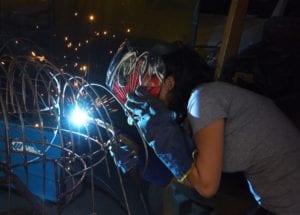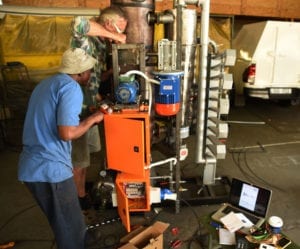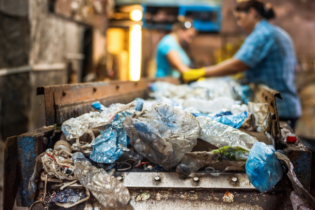In an effort to address the problem of plastic waste, deforestation and the continent’s energy crisis in one fell swoop, not-for-profit organisation Alliance Earth has created an incredible engineering solution that converts plastic waste into energy.
By Liesl Frankson The UN Environmental Programme says that around 8 Mt of plastic waste ends up in the world’s oceans each year. That’s the equivalent of a garbage truck full of plastic being dumped into the ocean every minute. At the same time, sub-Saharan Africa is facing a wood fuel crisis with massive environmental consequences, as the most dominant energy form for cooking and energy for many communities remains wood. The Dung Beetle Project aims to address these and other challenges in a fun and innovative way using art, education and technology that has existed for almost 100 years. The solution – a plastic gasification system covered by a steel structure in the form of a dung beetle – uses pyrolysis to heat plastic into a gas and then condense it back into usable fuels. “The Dung Beetle is really just a package to deliver what is essentially one of many solutions to a planetary crisis we face with the amount of plastics in our environment,” notes Jeffrey Barbee, environmental journalist and director of Alliance Earth.“The reason we packaged this solution as a dung beetle is because not only are dung beetles rather fabulous, but they do the work that most organisms overlook as probably beneath them. They take waste and turn it into something useful, which is what our Dung Beetle does.“If you think about it, people have made this system before; what we created here, we literally learned from YouTube – we have not done anything new, this type of technology has been around for at least 100 years. What we’re looking at here is adapting one solution to the plastic problem into a communications platform that is fun, fiery and hopefully unforgettable,” he explains.
Driving climate change and environmental education
The project has become a centrepiece for climate change and environmental education, and has garnered much attention since its debut at the AfrikaBurn arts festival in the Karoo earlier this year. The Dung Beetle was mounted on a trailer, along with a stage that allowed for a production that included live performances by artists, as well as talks and tours of the gasification technology.
“We chose to present this project as art because art is communicative in so many ways. When you’re talking about environmental education, it’s really important to engage people at many different levels. Through the project, we are driving not only information about how the Dung Beetle works but solutions about things like climate-smart agriculture and agroforestry solutions. We need to continue to adapt to such solutions in the world, which we are changing through pollution and greenhouse gases.”As the Beetle travels around the country, it uses the syngas it creates to power the lights and speakers for the roadshow. The syngas also fuels two torches that burn and shoot flames 2 m into the air out of the Beetle. The truck towing it is also powered using low-emission biodiesel.
Tackling pollution on all fronts
Barbee notes that South African townships are plagued by a pollution problem on multiple levels. “Many people eat lunch at street-side cafes, many of which use just a three-stone wood fire. Sometimes they even use anthracite coal for cooking food.“These things already have a heavy footprint problem but when you see the kind of air pollution that you see in South Africa’s townships, particularly in the winter time, with people using whatever forms of energy they can to cook with, it’s a no-brainer that a heat system with no release of hydrocarbons into the environment would be extremely beneficial. So, through our system, we are able to turn a local plastic problem into a local cooking solution, by changing plastics into usable fuels that have very little or no ecological footprint beyond cleaning up the plastic in the environment.”
Empowering environmentalism
Looking ahead, Barbee notes that Alliance Earth will continue to use the Dung Beetle Project as an educational art platform and there are plans to open a company that will manufacture these systems to empower the local community. “We would like to see people using this technology much more broadly because our main mission at the Dung Beetle Project is to see plastics removed from the environment in an ecologically safe way. Now, because we’ve had such a reaction worldwide, people want these systems for themselves, and we are looking at starting a separate project to build these systems.” According to Barbee, the new project will be based in the south of Johannesburg and will retrain people who have been put out of work by the mining industry to build Dung Beetles.“The aim is to create an alternative energy stream market that essentially monetises these types of systems and puts that energy and money into the hands of smallscale entrepreneurs in Southern Africa. The aim is to have a much larger ecological impact in terms of pulling plastic out of the environment,” he says.“The reason we are opting to lease and not sell them is so that we ensure that we hold on to the ability to innovate and make these systems cleaner, better, more efficient and more successful at removing plastic from the environment,” Barbee concludes











